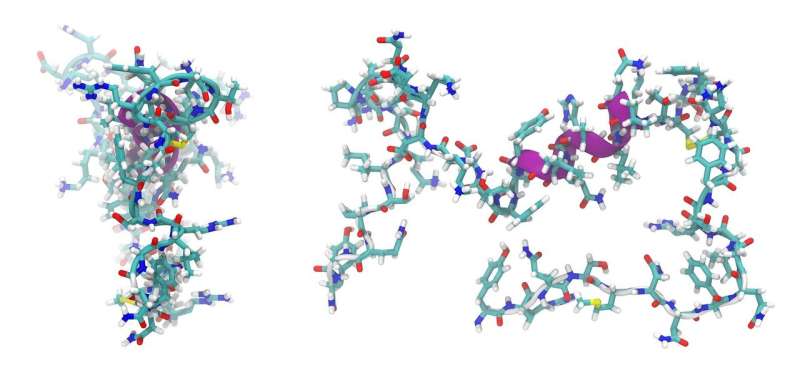Structure of a 'promiscuous' protein will help scientists design better drugs

Scientists at EMBL Hamburg and CSSB have determined the molecular structure of a gut protein that helps us absorb many drugs. This could help to develop drugs that reach target tissues more efficiently.
During digestion, the proteins we eat are broken down into tinier pieces called peptides, which consist of amino acids that our body later uses to build its own proteins. Before that happens, peptides must first be transported from the gut to the bloodstream. This task is performed by a molecule called peptide transporter 1 (PepT1), which sits in the cell membrane of the intestine wall and moves small peptides across the cell membrane.
In the human body, there are around 800 transport systems dedicated to different sorts of nutrients. Most of them are very specialized. For example, certain sugar transporters can take up only one type of sugar. However, PepT1 is different—it can transport almost any type of short peptide. In the scientific jargon, this ability is referred to as "promiscuity."
Group Leader Christian Löw is EMBL Hamburg's expert on membrane proteins. His group, together with colleagues from the Centre for Structural Systems Biology (CSSB) and the Universitätsklinikum Hamburg-Eppendorf (UKE), has determined the molecular structures of human PepT1 and its relative PepT2, which is present mainly in the kidney for nutrient resorption. The scientists used cryo-electron microscopy, a technique in which frozen samples are imaged using electrons instead of light.
New possibilities to improve drug design
The promiscuity of PepT1 enables it to transport not only nutritious peptides but also various types of drug, including certain antibiotics, antivirals, and drugs for hypertension. However, PepT1 transports drugs less efficiently than it transports many of the natural peptides. As a consequence, only a fraction of the drugs we take in end up in our bloodstream. The rest stays in the gut, which may lead to various side effects. Increasing the dosage of drugs to make up for inefficient transport is particularly dangerous in the case of antibiotics, because it may lead to the generation of antibiotic-resistant bacteria.
"Now that we know what the PepT1 structure looks like, it will be possible to design new drugs that exploit PepT1 to cross the gut wall much more efficiently than before," said Löw. "The structure of human PepT1 will allow us to improve drug design by making the absorption more efficient. Currently, it's almost impossible to predict whether a drug candidate can cross the gut wall via this transport system. Until now, obtaining such a drug has been very challenging. Many potentially effective drug candidates have failed in preclinical studies because they were poorly absorbed. With the help of the structural information for PepT1, some of those failed candidates could be redesigned so that they could be transported efficiently by PepT1. Similarly, many existing drugs could be modified to improve their absorption."
Watching the transporter in stop-motion
The molecular structure of human PepT1 is among the smallest structures determined with cryo-electron microscopy. It resembles a clamp that is open towards the inside of the gut. When a peptide binds to PepT1, the clamp closes around it and then opens to the other side of the membrane to release it. The scientists not only determined the structure of the transporter but even captured it in various states along the transport cycle.
"We visualized the entire transport process in molecular detail, like in a film," said Maxime Killer, first author of the study. "Membrane proteins are notoriously difficult to study, but we hope that the tricks we developed to study PepT1 will help other scientists to solve the structures of similar proteins in the future."
More information: Maxime Killer et al, Structural snapshots of human PepT1 and PepT2 reveal mechanistic insights into substrate and drug transport across epithelial membranes, Science Advances (2021). .
Journal information: Science Advances
Provided by European Molecular Biology Laboratory



















